There is no shortage of temples and shrines in Kyoto. But, one of the most visited temples is the hilltop complex of Kiyomizu-dera or “Pure Water Temple”. Located on the halfway point of eastern Kyoto’s Otowa Mountain, it is rich in history, beauty and architecture. See why pilgrims and visitors have made the trek to Kiyomizu-dera for centuries.
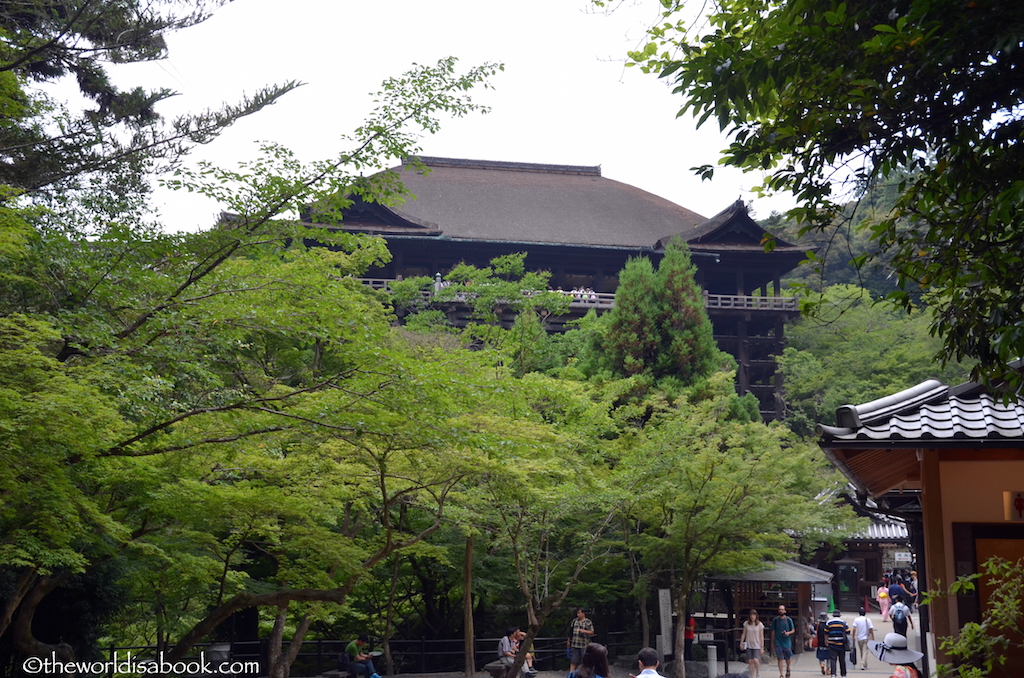
History of Kiyomizu-dera Temple
They named the Kiyomizu-dera temple after the pure waters of the Otowa Waterfall that flowed from the mountain spring. Enchin, a Buddhist priest from the city of Nara, stumbled upon this forest with a waterfall at the base of Mt. Otowa after having a vision to “Look for the clear water origin of the Yodo river”.
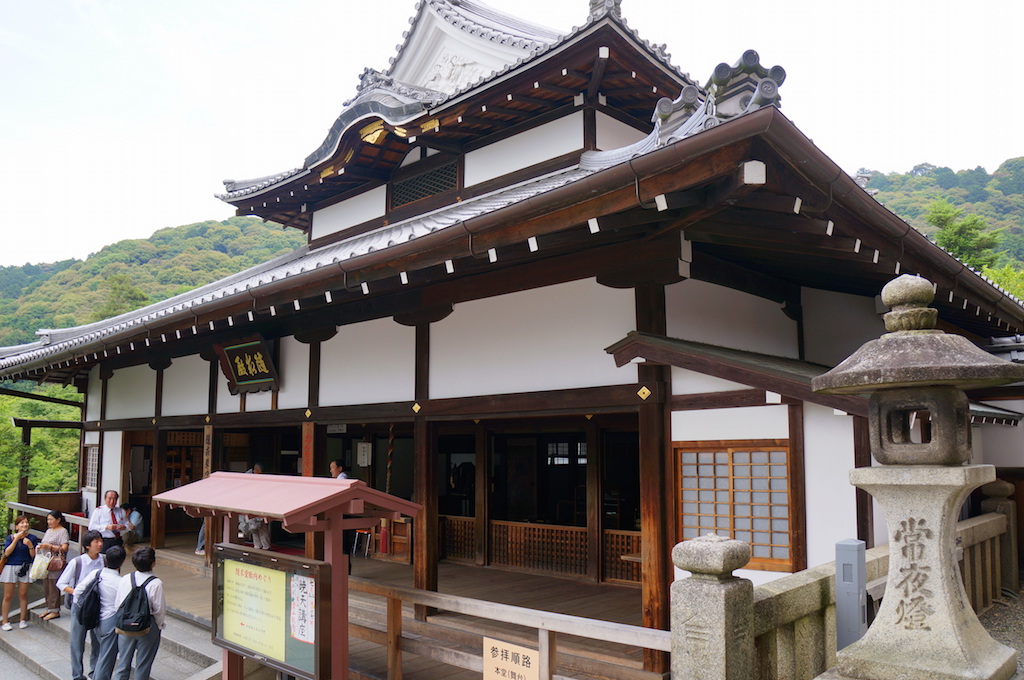
Kiyomizu-dera was established in 778 and was built in honor of the Goddess of Mercy and Compassion. Unfortunately, the temple has burned down several times over the centuries.
Between 1631 and 1633, they rebuilt many of the existing buildings in the complex. The temple complex houses 15 colorful halls dedicated to various deities and pagodas. Some were more vibrant than the others but all made of wood. UNESCO declared Kiyomizu-dera a World Heritage site in 1994.
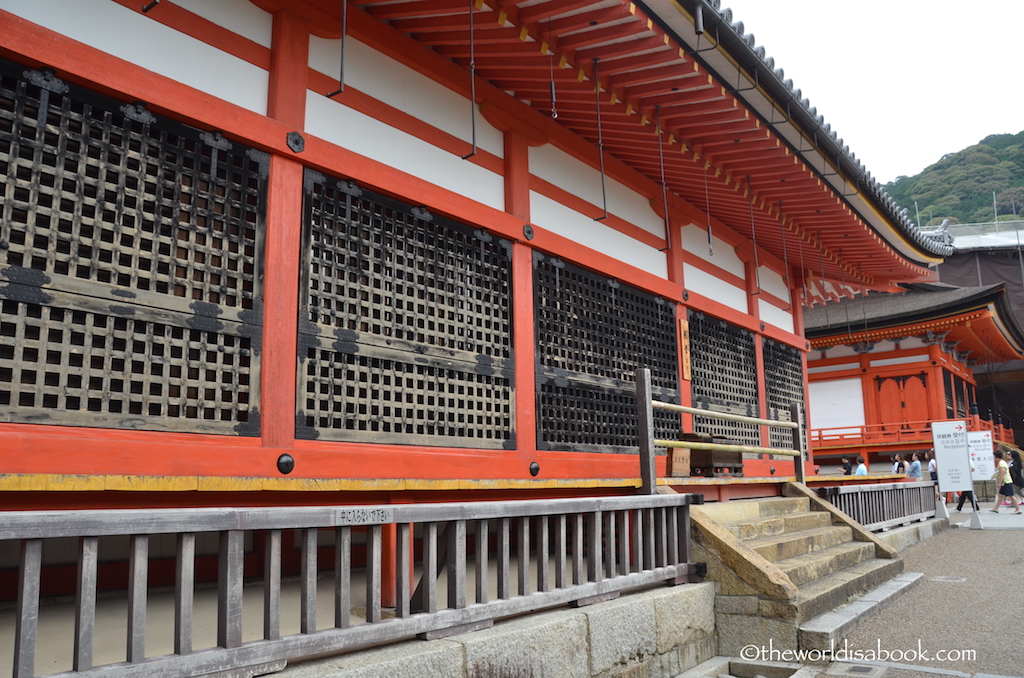
After our stroll through the historic Higashiyama district, the street led up to the Kiyomizu-dera grounds. We had to navigate through a busy street lined with many shops and restaurants on both sides. It was hard not to stop at each store which sold so many unique and interesting souvenirs.
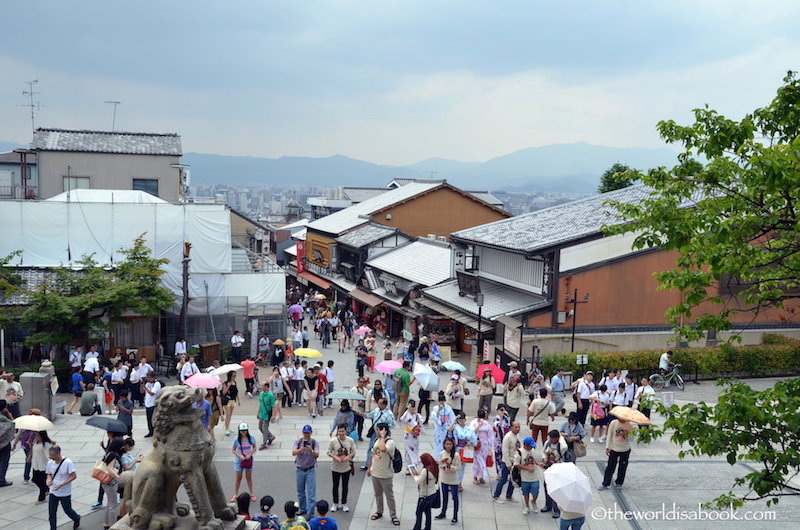
It got a bit crowded between the worshippers, tourists and kids on fieldtrips on a June weekday. We saw many women here dressed in traditional attires with their colorful kimonos, yukatas (the cotton ones worn during summer) and getas (Japanese footwear).
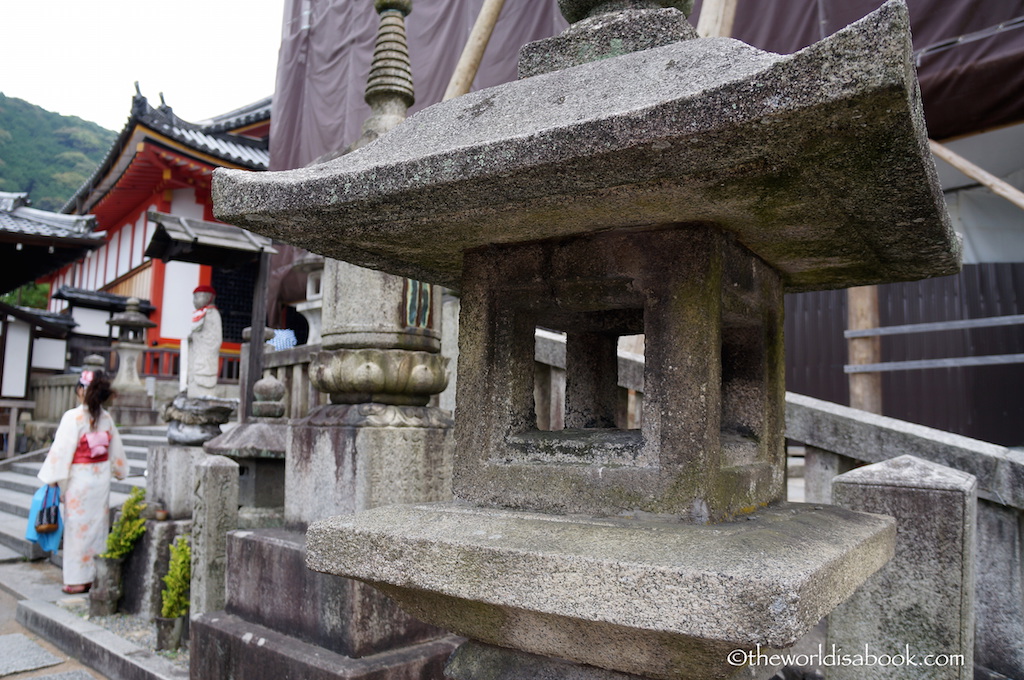
Kiyomizu-dera Temple Entrance
The Niomon or Deva Gate was the first structure that greeted us. This was the main entrance into the temple grounds. The Deva-Kings and the Korean lion-dogs or koma-inu statues here are meant to ward off evil from entering the temple grounds.
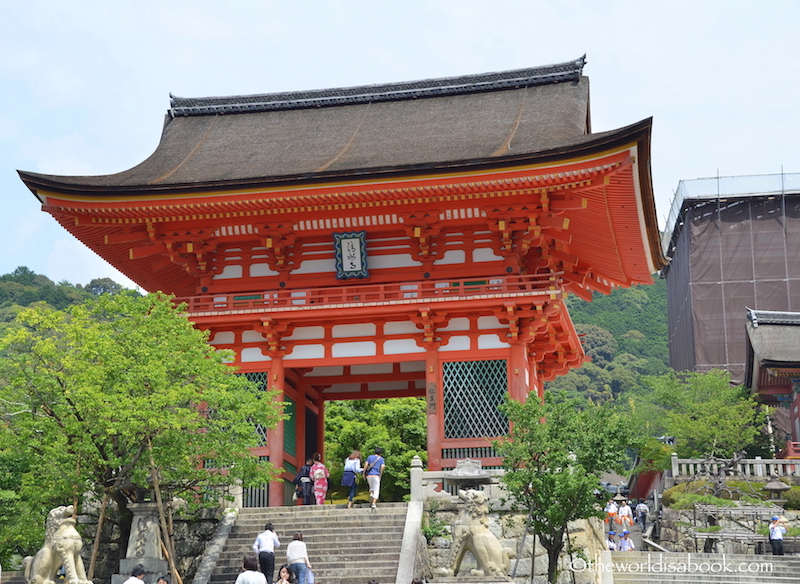
This bell tower was next to the Deva Gate.
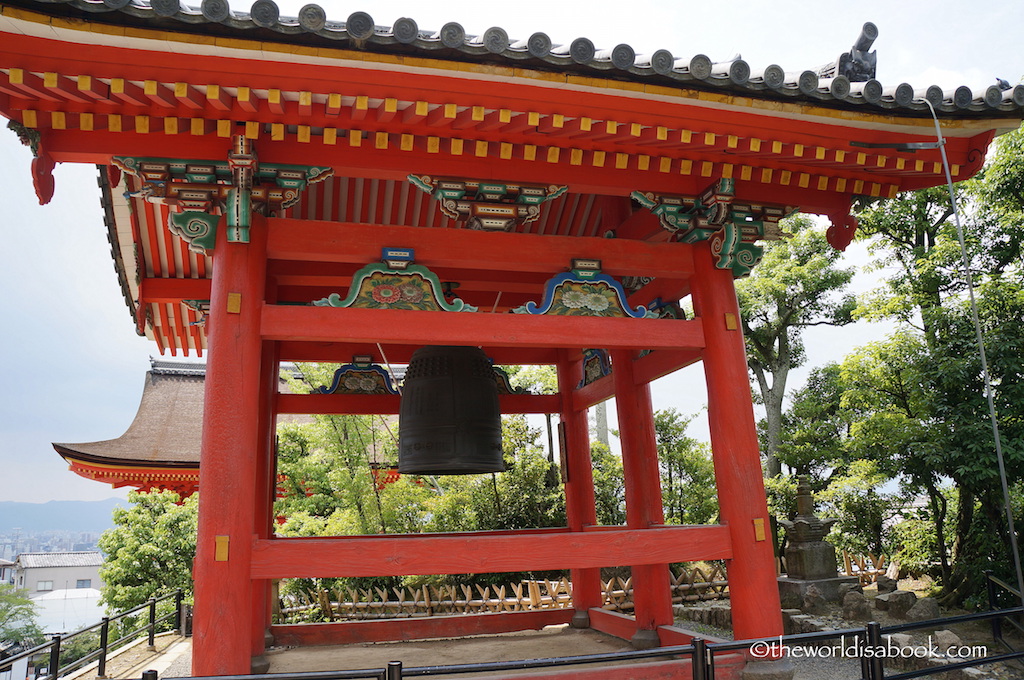
This was the cleansing station near the entrance for washing hands to purify one’s self before entering the sacred grounds. My kids always enjoy and look forward to doing this ritual.
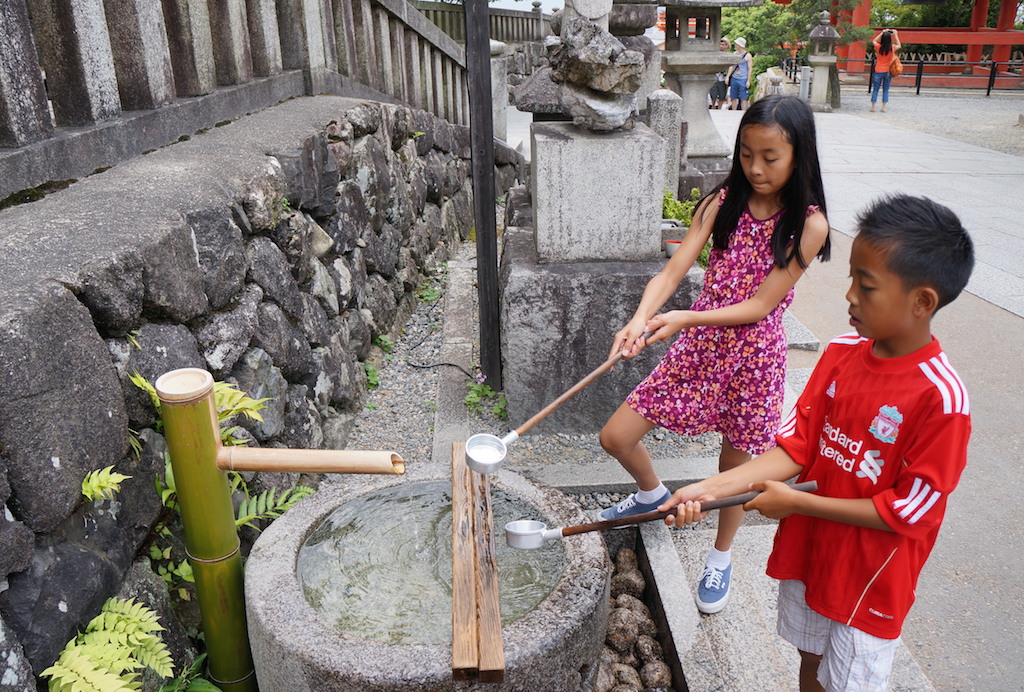
We always love seeing these ema votive tablets hanging at temples and shrines. The worshippers use these wooden plaques to leave their prayers and wishes. Since 2014 was the year of the horse, it was prevalent on the tablets.
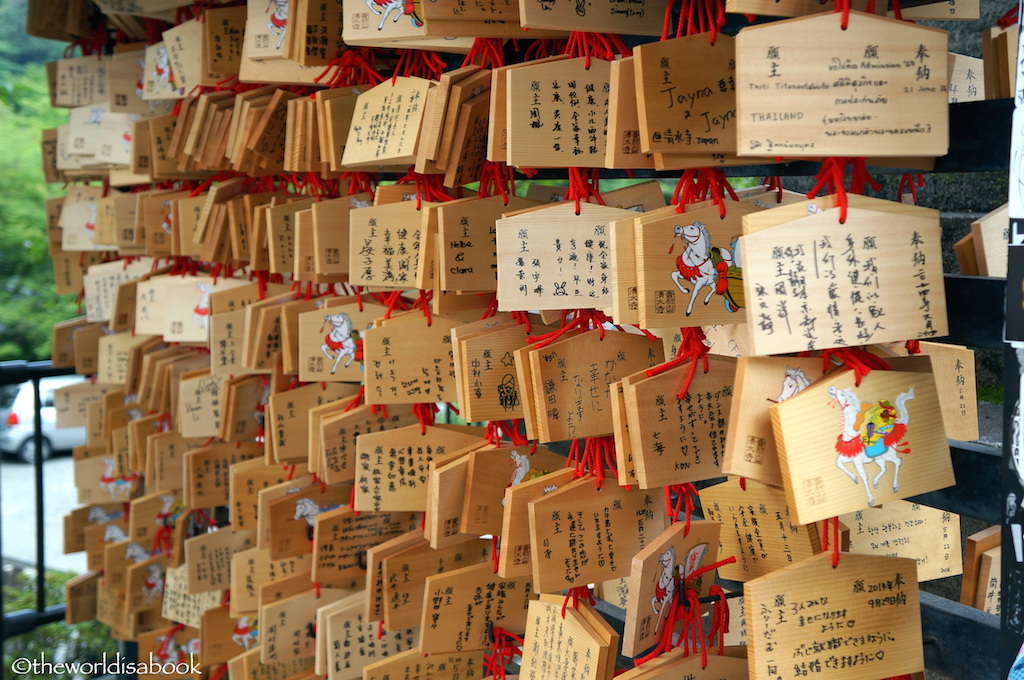
Kiyomizu-dera Temple
The star attraction here is the Main Hall or Hondo, considered a national treasure. It honors the Eleven Headed and Thousand Armed Kannon Bodhisattva, known for answering prayers and granting wishes.
They enshrined the small statue here, which many primarily worship. The Kannon is hidden and only revealed to the public every 33 years. The last showing was in 2010.
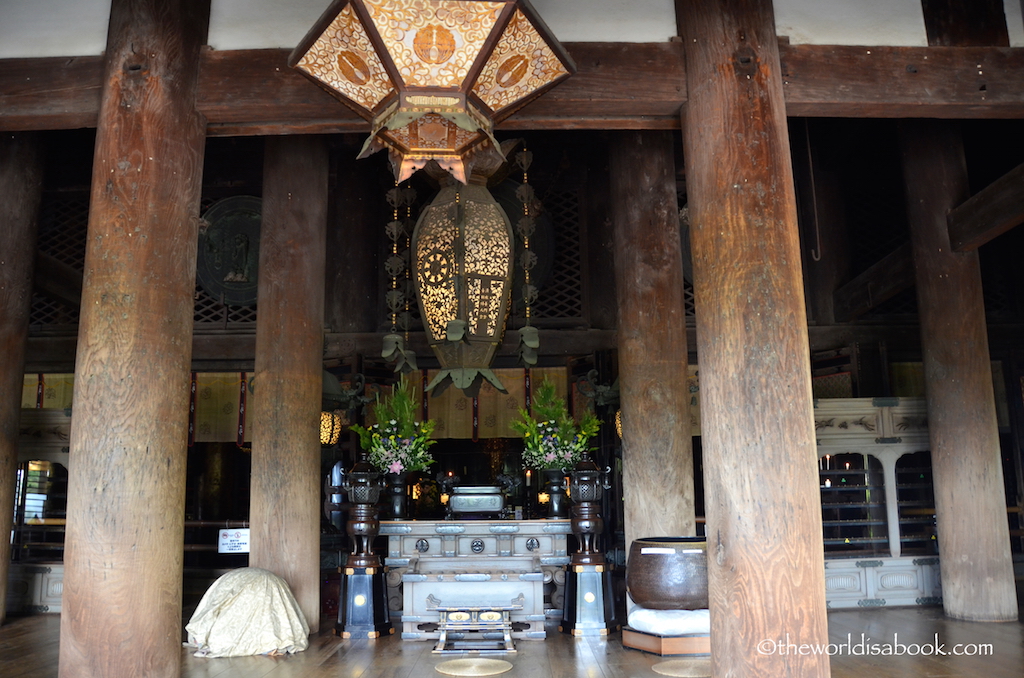
Though, most of the visitors flock towards the Kiyomizu Stage which is the wooden veranda that extends from the main hall and 43 feet (13 m) above the hillside. The large space accommodated all the visitors. So, we didn’t feel like our private spaces were being invaded.
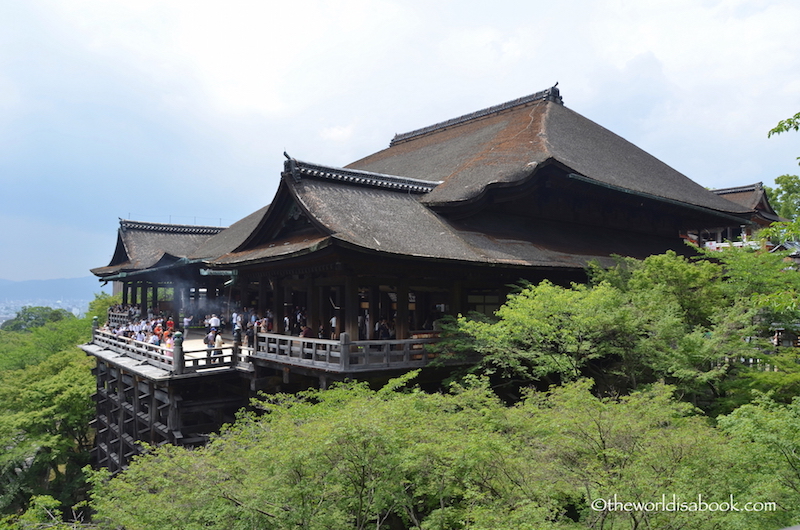
The stage was the best place to see views of Kyoto and the surrounding area. It was a little smoggy during our summer visit but still beautiful which included the prominent Kyoto Tower.
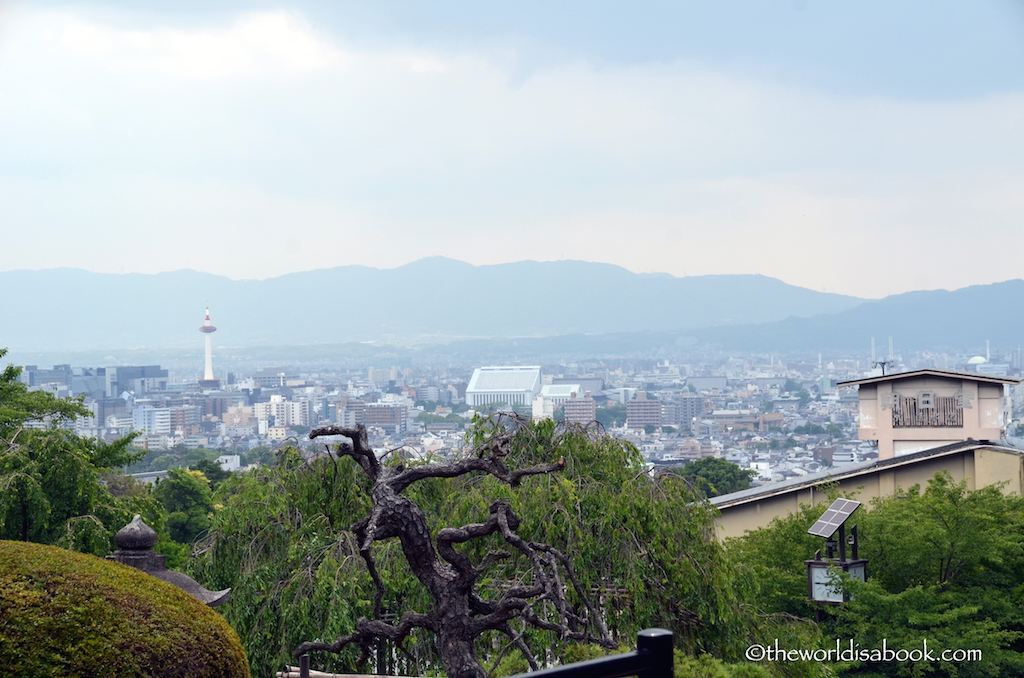
It’s amazing to learn that the stage and Main Hall they built them without using a single nail. They crafted these 45 feet (12 m) high pillars and crossbeams from keyaki or Japanese zelkova tree. The floors consist of over 410 cypress boards.
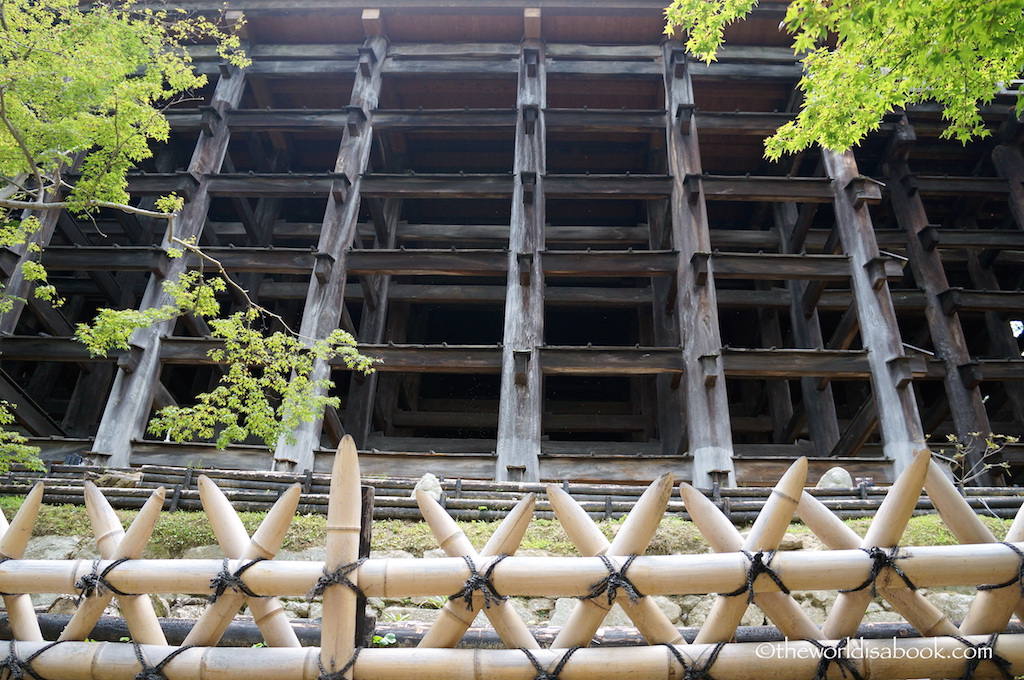
We found some small isolated spots like this area. It was a nice respite from the crowd and heat. These Kyoto temples might exude zen and peacefulness but we found them too crowded and distracting to enjoy it in peace. I don’t know how some people were able to pray with the constant chatter and picture clicking.
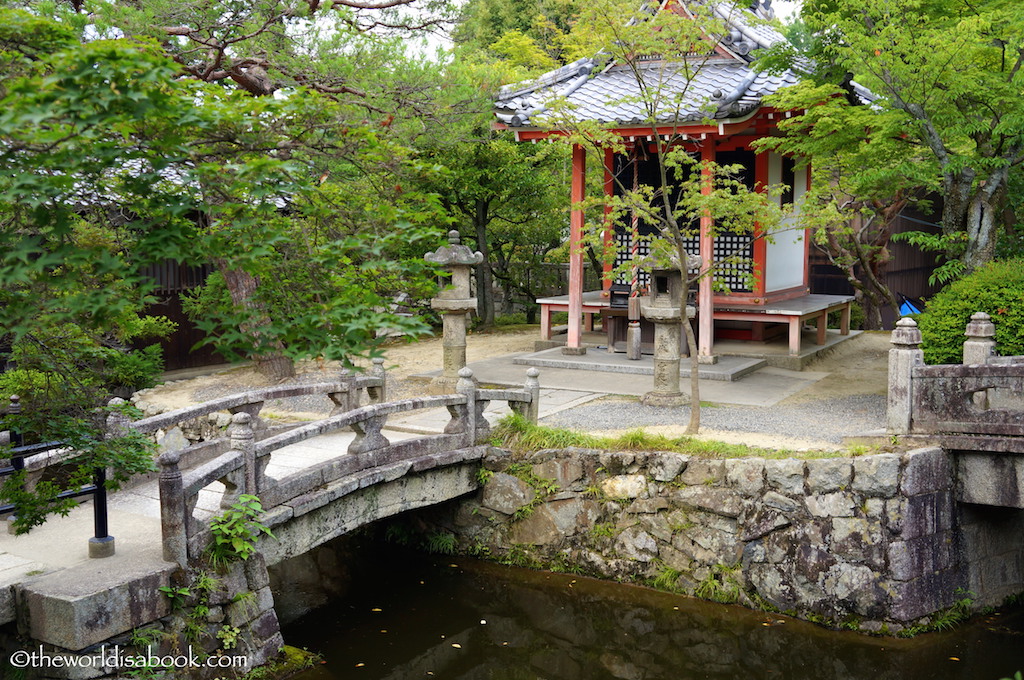
Kiyomizu-dera Pagoda
Located across from the Main Hall and veranda, the three-storied, vermillion Koyasu pagoda was quite a sight to see nestled among the greenery. This place gets quite busy during Spring and Autumn when the area’s cherry blossoms and maple trees put on a stunning display of blooms and colors. I can just imagine how beautiful these trees transform into.
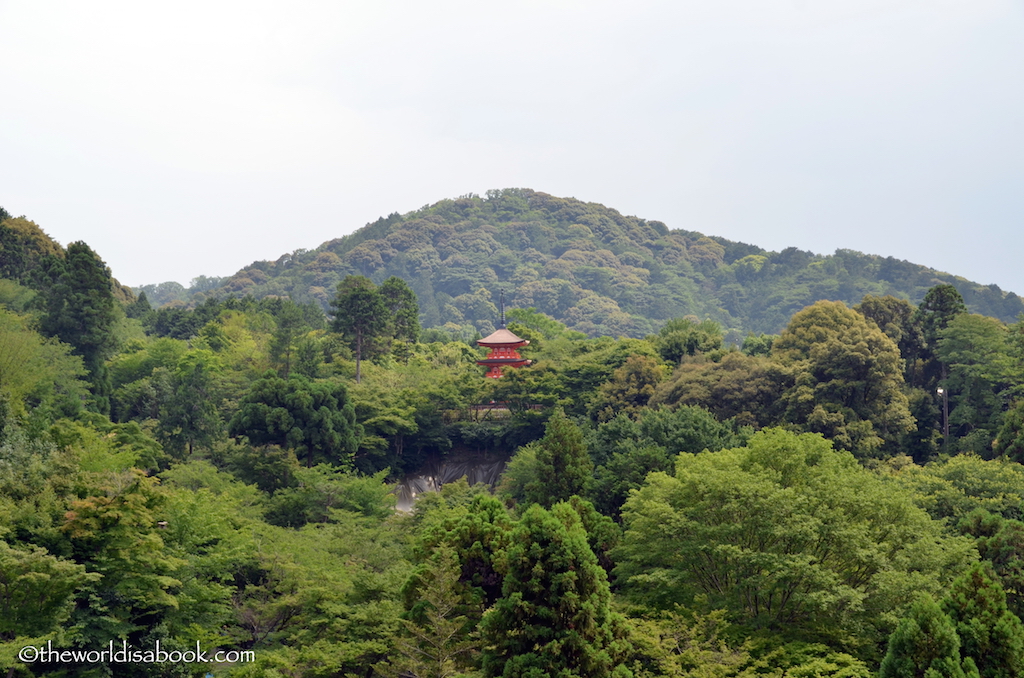
It took us awhile to walk across to get a closer look at this pagoda. But, it was a pleasant stroll through the shade and some gardens. It was one of the few places that offered a serene spot and experience.
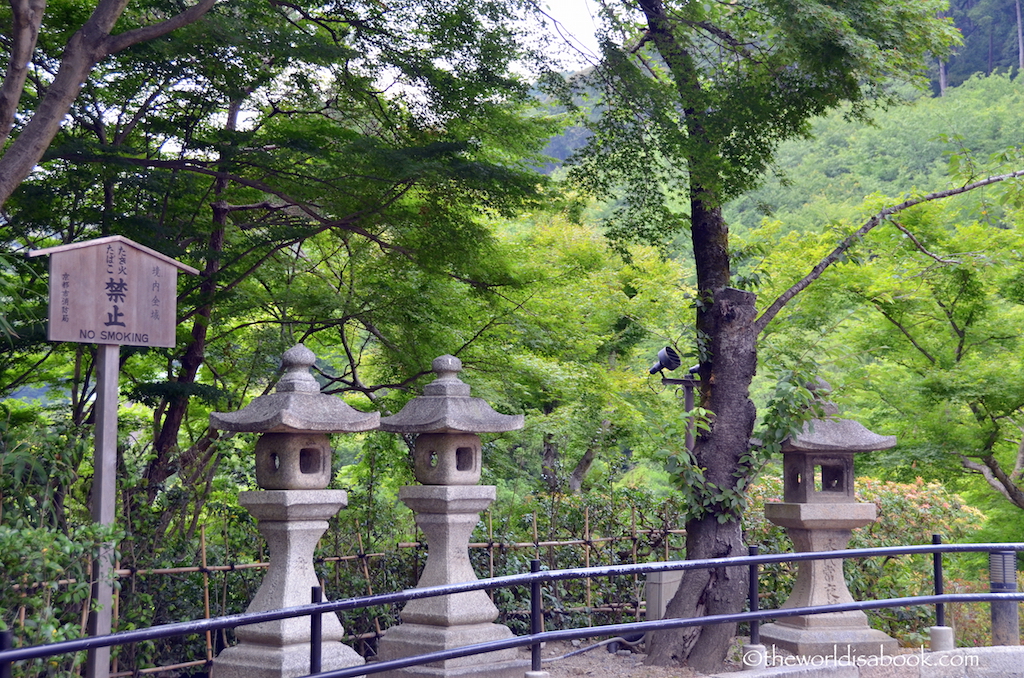
Along the way we passed by these Jizo statues which were the protector of women, children and travelers. Parents adorned statues with red bibs as a gesture of gratitude for saving a sick child or as a plea for Jizo’s protection for a child who has passed away. They believe the color red banishes demons and illnesses.
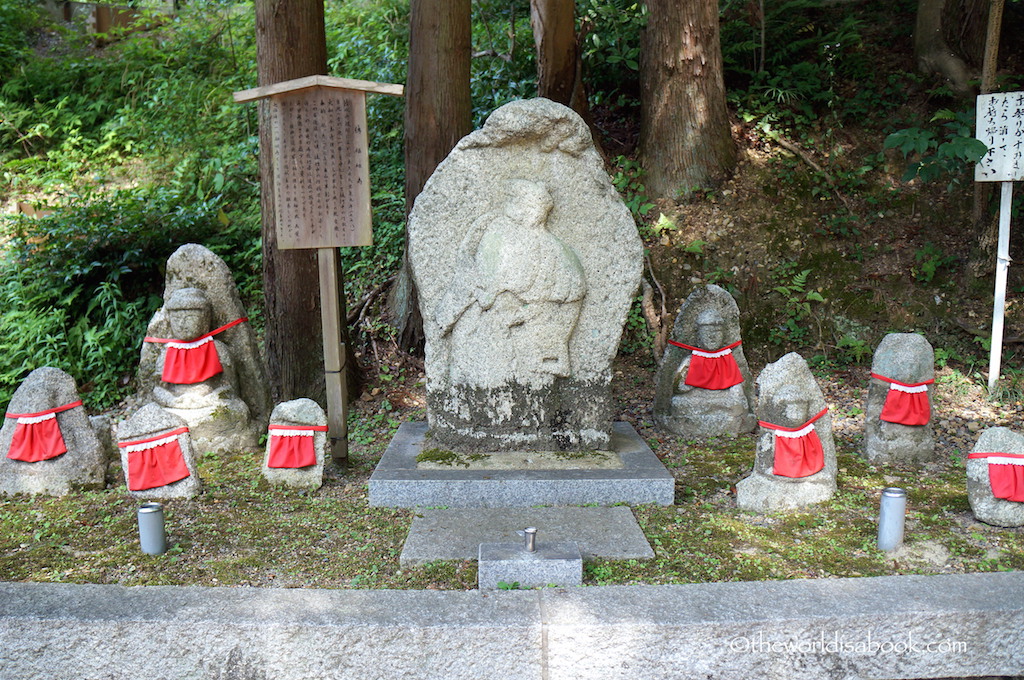
According to some beliefs, visiting the Koyasu pagoda brings pregnant or prospective mothers an easy and safe childbirth. My visit here was a few years late. I could have really used the easy childbirth benefit.
The Koyasu pagoda is beautifully constructed and vibrant. It wasn’t open, so I’m unsure if visitors were allowed inside.
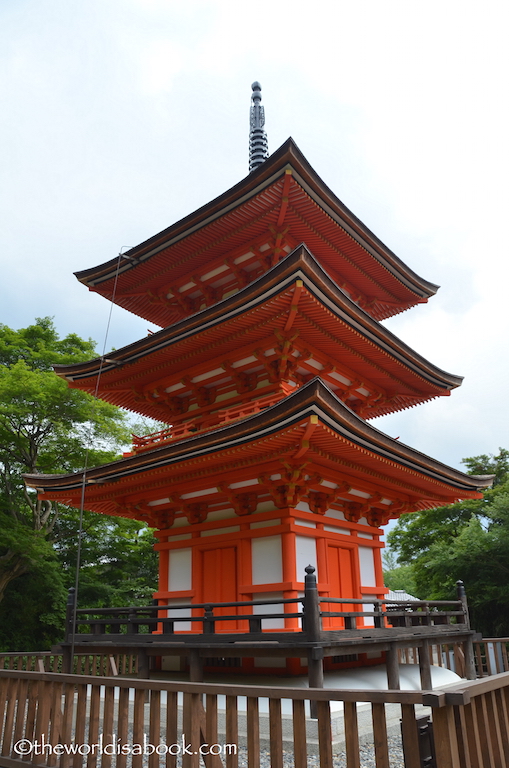
There wasn’t much around this area but one can really get a sense of the size of the main prayer hall and veranda across the way from this vantage point.
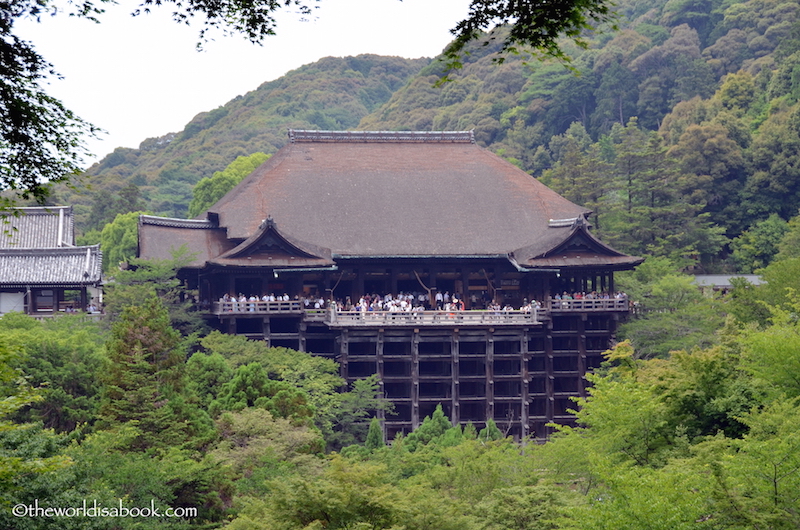
Kiyomizu-dera Waterfall
One can’t miss the flowing Otowa Waterfall below Kiyomizudera’s main hall base. It’s not a gushing waterfall but was actually three separate streams of sacred Otowa Water. We found a long line of people here who were drinking from the overhead streams using a ladle.
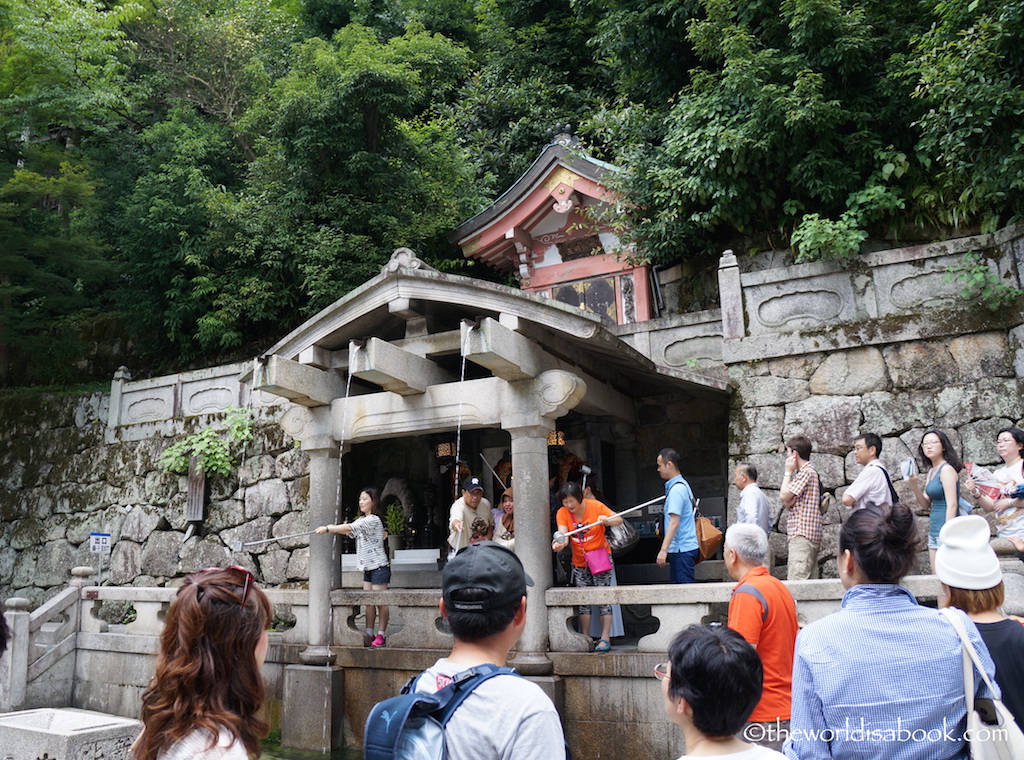
Drinking from each stream yields different advantages which were success at school, luck in love or a long life. Visitors must choose from the three. Drinking from all of them is considered too greedy.
The kids didn’t want to wait in the heat, and the semi-germaphobe in me wasn’t too keen on drinking from and sharing a cup that thousands of strangers had sipped from.
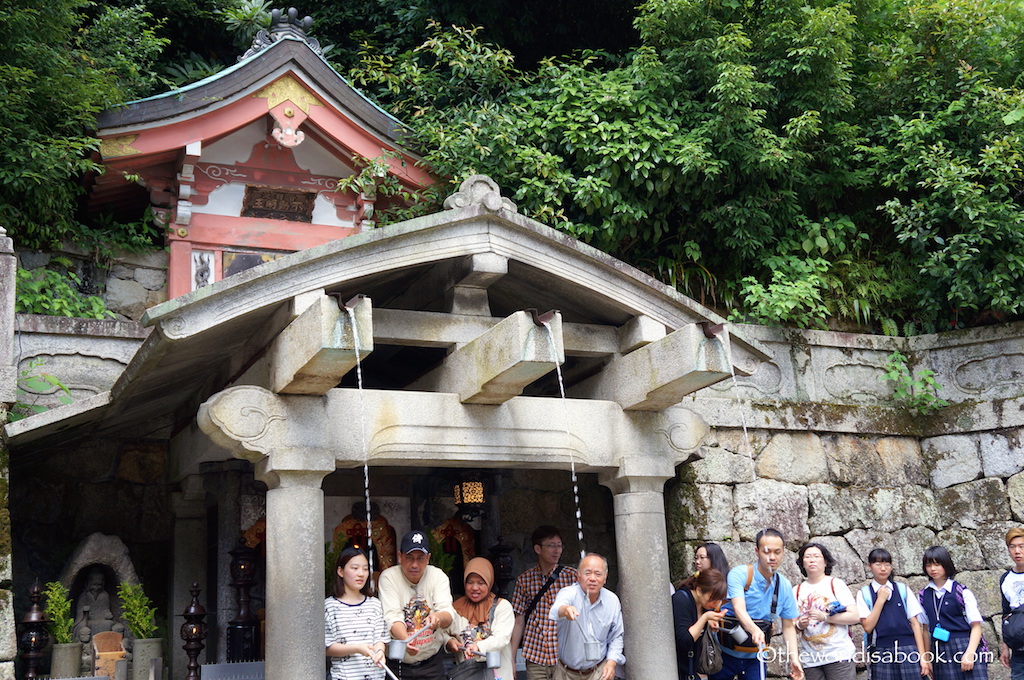
It was easy to see why visitors flock to Kiyomizu-dera temple everyday. The grounds and structures were beautiful, clean and well maintained.
Despite the heat and crowd, we had a wonderful few hours here admiring the structures, enjoying the views and learning a bit about Buddhism. It’s worth making the trip here no matter how limited your time may be in Kyoto.
Tips for Visiting Kiyomizu-dera Temple
- Admission Prices: Adults: 300 yen ($2.50 US)/ Students 200 yen ($1.70 US)
- Opening hours: 6:00 AM everyday; closing time varies based on seasons but the latest is at 6:30 PM during April – September.
- Getting There: Take Bus 100 or 206 from Kyoto Station. The bus stops are Kiyomizu-michi or Gojo-zaka. It’s an uphill 15-minute walk to the temple. We got here after our walk through Higashiyama District and then took the bus back to Kyoto station.
- The street leading up to the temple was the best place to sample and buy Kyoto’s famous sweet treats called Yatsuhashi. They’re made from rice flour, cinnamon and sugar. Allocate some time in this bustling street to browse the shops.
The World Is A Book contains affiliate links and is a member of the Amazon Services LLC Associates Program. If you make a purchase using one of these Amazon links or any of the product links, we may receive compensation at no extra cost to you. See our Disclosure Policy for more information.
Check out these Kyoto tours!
Have you visited the Kiyomizu-dera temple in Kyoto?
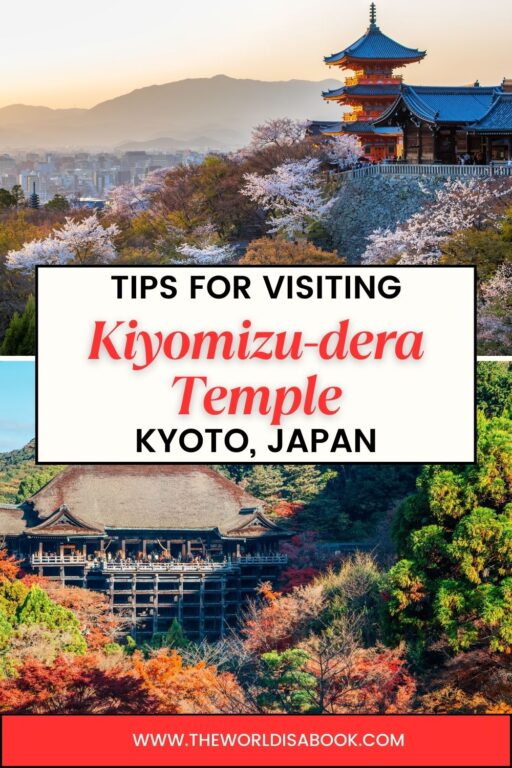
Such a beautiful place, impressive structure and such stunning views!!!
It was an impressive complex.
I agree that it’s one of the top places to see in Kyoto. I thought perhaps June would be less busy but it seems just as crowded as when we were there during Cherry Blossom season. I also got distracted by all the shops along the road leading to it, and we also decided not to join all the people drinking from the communal waterfall cup. It looks like your family had a great time at Kiyomizu. Did you make it to the Love Stones?
Unfortunately, we didn’t make it to the Love Stones. It looked so interesting. I would love to see this during cherry blossom season. I loved those shops and I could have stayed there all day browsing.
Mary, I have visited this temple…years ago. My daughter is living in Japan, so am planning another trip there next summer. I’ve got to get back to Kyoto. It’s beautiful!
Love Kyoto. Lucky you for being able to return and with good reason.
Mary…As always, thanks for linking up to Weekend Travel Inspiration!
To answer your closing question, no, I have never visited this Kyoto temple. I have never been to Japan, and I’m not sure I’ll ever get to go. What a fascinating country!
It is! I hope you get to visit it one of these days.
We have visited this temple and as with all of Kyoto was enchanted #wkendtravelinspiration
Great to hear, Paula! Enchanted is one of the words I would describe of how I felt in Kyoto.
Japan is next-up on my travel schedule, so I’ve read this with great interest (and bookmarked for future reference) and I’ll be trawling my way through ALL your Japan posts!
I hope the posts help! Safe travels and I’m sure you’ll enjoy your visit to Japan.
Beautiful and interesting. I love those three waterfalls at the end, and so agree about the communal cups. We have run into that in several countries and I always try to avoid them. Hubby always drinks and thinks I am missing out. Thanks for linking up at weekend travel inspiration.
Great photo…
Absolutely gorgeous! I am currently reading a novel that’s set in Kyoto, it’s nice to see some pitures about it!
What an enchanting place, simply gorgeous.
Reading about Japan always makes me nostalgic, the beauty and the simplicity of the country swept me off my floor. This temple, like the numerous other temples in Kyoto seems to exude that peaceful and calming radiance. Superb pictures Mary :)
Japan is such a fascinating country. The Japanese architecture always fascinated me, but unfortunately I haven’t been able to visit Asia so far. I enjoyed reading your detailed description of Kiyomizu-dera in Kyoto. It would be nice if I could visit it in person.
I’m so impressed. I had no idea that Japanese shrines can be this complex and involved. I’ve not been to Japan yet but it’s been high on my list for ages. Now I realize that I have to make sure that I plan enough time to explore the sites. Thanks for the heads up.
#theweeklypostcard
I love the picture showing the weathered stone of the temple, with the woman in a kimono in the background – duch fascinating detail! And those votive tablets are really cool.
I visited this place when I was in Japan for just 3 days as a stopover between Bali and the U.S. I loved it and loved our short time in Kyoto. I’d love to go back to Japan when my kids are a little older.
What a lot of lovely pictures and useful information. What’s with the red colour? Does it have any particular significance in relation to Japanese beliefs?
Such a beautiful temple – I would love to visit Japan one day & I really like the thought of those tablets where people write their prayers, thoughts and wishes – such a nice idea!
I did visit this temple the last time I was in Japan. I remember standing at the lookout area. I seem to remember that it was quite hazy that day. Walking to the temple was definitely an adventure. I kept stopping and gawking in the shops along the route!
I’m dying to visit Japan right now. I’ve postponed a trip before and have regretted it ever since… I think the time has come. Thanks for inspiring me and thanks for linking up with Weekend Travel Inspiration!
Thank you for this reminder of two wonderful years spent living in Japan! Was it on my very first trip to Kyoto that I visited Kiyomizu-dera? And the striking Golden Pavillion, Kinkaku-ji, too? Enjoying this opportunity to read more about Japan at #TheWeeklyPostcard.
I visited Kiyomizudera in the early spring and by night, when the cherry trees (Sakura) were in the full bloom. I will never forget that – it was like a fairy tale! I’d love to be back in Fall, when the leaves turn red!
Found you via #TheWeeklyPostcard :)
I’m with your kids, out of all that…and it ALL sounds amazing…I was soooo intrigued by the cleansing station, Mary! :)
I love learning about the symbols and connections in Japanese cultures. All of the unique temples in Asia are reasons I want to see more of the continent. What time of the year would you suggest going?